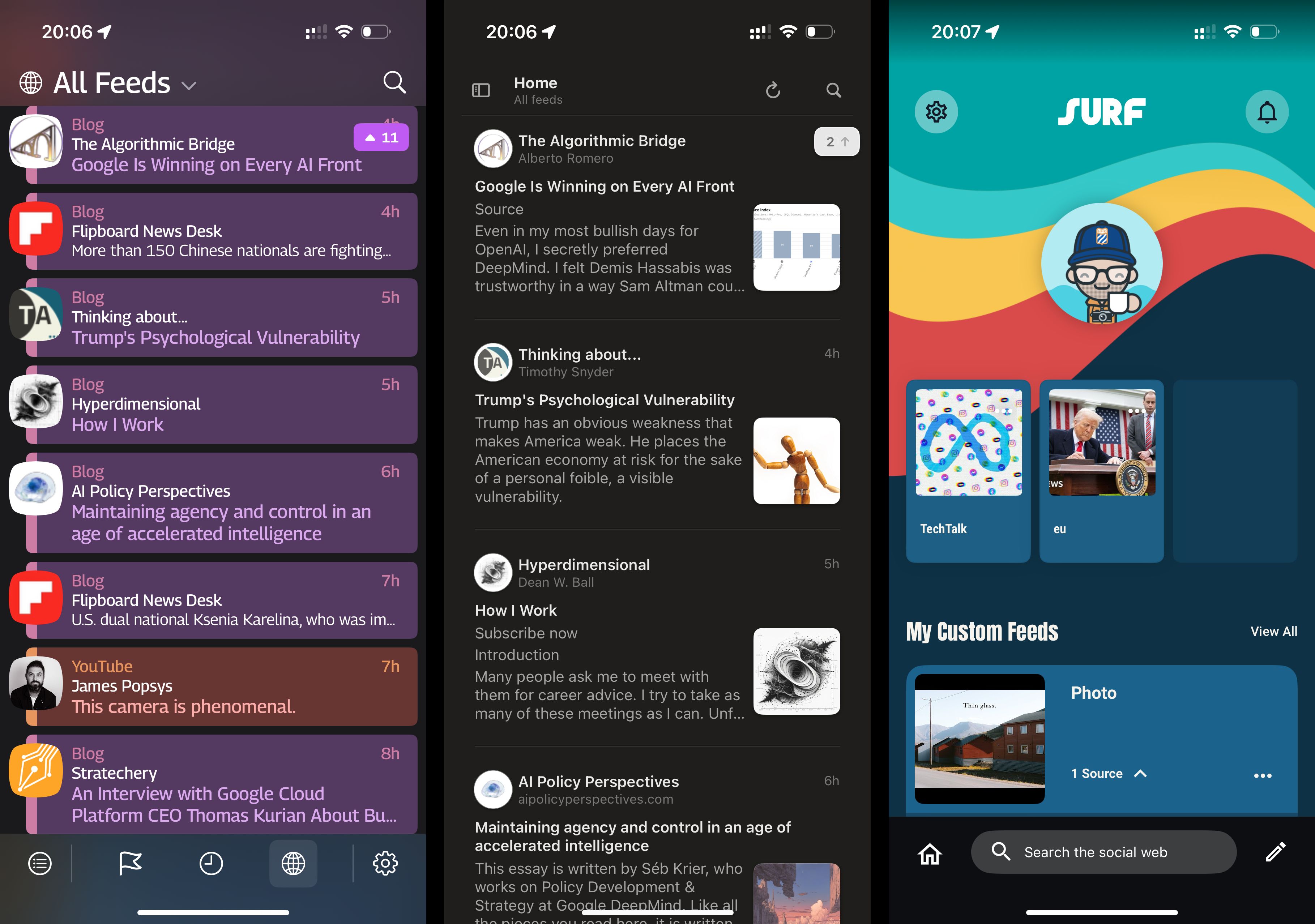Being an internet user means constantly jumping between different services and websites to check what's new. But there are alternatives. Tapestry, Reeder, and Surf are three apps that let you gather much of the content you're interested in—all in one place.
(🇸🇪 Det finns en svensk översättning av den här texten.)

The podcasts I listen to, my YouTube channel subscriptions, posts from Bluesky and Mastodon, blogs, and a few other kinds of feeds. All collected in one single app. That’s exactly what Tapestry, Reeder, and to some extent Surf let you do.
The idea is simple, and for all three, partly a response to what happened when users began leaving Twitter/X for Mastodon, Threads, or Bluesky: The fact that suddenly there was no one place where "everyone" had an account. The network people had built on Twitter was suddenly scattered across three (or four, since not everyone stopped using Twitter).
Messy. Pick one place to move to, or all three?
Thanks to the openness of Mastodon and Bluesky, it's possible to follow accounts across network boundaries.
And that’s the kind of openness that Tapestry, Reeder, and Surf are built on.
Because online, there are two types of services: Those that are open (which, among other things, means it's possible for developers to build solutions for them and that content is accessible without a special account), and those that are closed. And around the open ones, vibrant ecosystems often emerge. Like around Twitter—while it had an open API that third-party developers could use.
From time to time, I send out a newsletter.
Like RSS for the 2020s #
If you’ve used RSS to subscribe to blog posts, you’ll feel right at home: These three apps function as a kind of digital mailbox, where new posts from the accounts you follow on various services appear as they're published.
The small difference from RSS is that these new apps let you subscribe to many more kinds of feeds.
The big difference is that these new apps are much more intuitive, likely due to two reasons:
- Most internet users today are used to thinking in terms of feeds.
- Unlike (most) RSS readers, these three apps prioritize not only function, but also user-friendliness. And that’s probably no coincidence.
So maybe now everything is in place for a significantly broader breakthrough than RSS ever achieved.
Veteran developers building for a reborn open internet #
One of the companies that made a name for itself in the Twitter ecosystem was Iconfactory, with the Twitter app Twitterrific (which featured a blue bird icon—something Twitter later adopted for its own logo). In January 2023, the app suddenly stopped working. The company went back to the drawing board and came back with Tapestry.
Flipboard is another familiar name to many internet users. They made a splash with an app for digital magazines and are now investing heavily in open social media. As part of that effort, they launched Surf.
Reeder is the product of an Italian indie developer who previously created an RSS reader by the same name. Not well known to the masses, but a highly appreciated app among those of us who love RSS.
It’s probably no coincidence that these are developers who’ve been quick to adapt to the reshuffling that’s been happening on the internet over the past two years—primarily the shift from Twitter to the new alternatives. A reshuffling that marks a return to a time when most services online were open, not walled gardens.
Reeder is my current favorite #
As mentioned, I’m currently using all three apps in parallel. Even though they aim to fulfill roughly the same function, they do it in slightly different ways.
Reeder, in my opinion, has the most attractive interface, the best YouTube support (you can watch videos directly in the app without getting sucked into recommendations), and is available for both iPhone and Mac.
I’m not a big fan of Tapestry’s design, but on the other hand, they’ve created their own ecosystem where users can develop “connectors” (small snippets of code that fetch content from a server and make it available in Tapestry) to subscribe to various services.
Surf, finally, has an interface that stands out compared to the other two, and it is a matter of taste if you like it or not, and not quite as many supported services. But it does offer plenty of curated lists to follow and is really good for keeping up with current news.
Only chronological feeds #
All three apps also have one more thing in common: They lack sorting algorithms. All subscriptions are displayed in chronological order. What you can do as a user, however, is organize them into separate timelines however you like (one with close friends’ social media posts, one collecting photoblogs and photography YouTube channels, and so on).
It makes it easier to tell whether you’ve read everything or not. And no risk of endlessly reloading your feed to see what the algorithm digs up next.
